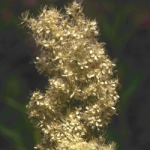| Common Name: |
Queen of the Meadow |
| Other Names: |
Joe Pye Weed, Gravel Root |
| Botanical Name: |
Eupatorium purpureum |
| Genus: |
Eupatorium |
| Family: |
Asteraceae |
| Native Location: |
E USA |
| Cultivation: |
Moist soul in sun or partial shade. Cut stems almost to ground level in autumn after flowering. Eupatorium purpureum prefers alkaline soil. Some species are subject to statuatory controls as weeds in parts of Australia. |
| Propagation: |
By seed sown in spring; by division in spring. |
| Harvest: |
Plants are cut when in bud, and dried for use in infusions, liquid extracts, tinctures. Rhizomes and roots are lifted in autumn, and dried for use in decoctions or tinctures. |
| Height: |
1.2m-3m (4-10ft) |
| Width: |
1m (3ft) |
| Variations: |
Album
Has white flowers.
Atropurpureum
Has deep purple-pink flowers. |
| Hardiness: |
Z3-10 |
| Parts Used: |
Rhizomes, roots |
| Properties: |
A slightly bitter, restorative, cleansing herb that acts especially on the genito-urinary organs and uterus. |
| Medicinal Uses: |
Internally for kidney and urinary disorders, including stones, cystitis, and urethritis; for prostate problems (combined with Lamium album, See white deadnettle); and for painful menstruation or a history of miscarriage and difficult labor. |
| Bibliography: |
Encyclopedia of Herbs by Deni Brown Copyright © 1995, 2001 Dorling Kindersley Limited Pp 208-209 |
